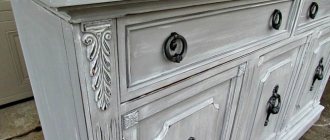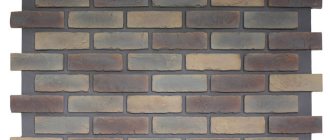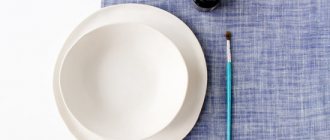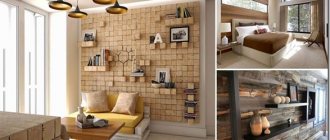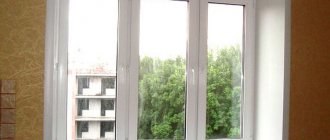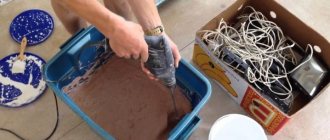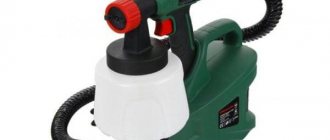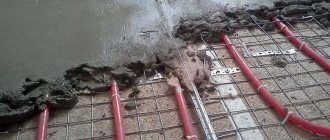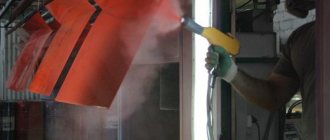Common types of stained glass
- sandblasting - is a group of glasses united by a compositional idea;
- mosaic - has a geometric structure and resembles a mosaic;
- typesetting - does not require painting, is created from pieces of ready-made glass;
- “Frost” pattern - achieved by applying glue or gelatin to the glass;
- natsvet - thin colored glass is superimposed on thick colorless glass, which allows you to create contrasting patterns;
- bending - giving a stained glass product various shapes in a kiln;
- contour fill - painting on glass with acrylic polymers using a contour.
- The fusing technique allows you to create volumetric stained glass windows of stunning beauty.
How to make stained glass with your own hands
Let's take a closer look at stained glass manufacturing technologies and master classes.
Every creative work, including making stained glass with your own hands , begins with a sketch of the idea.
- First, decide what size your product will be, and develop a sketch on thick paper or cardboard of the same size.
- Clearly draw the contours of each element of the drawing, dividing it into shapes.
- Specify the color and material of each piece.
- If necessary, number the fragments, write notes and necessary symbols to make making stained glass at home easier.
Stained glass drawings are a whole art. If you don't have the ability to draw or simply don't have any ideas, print out ready-made stained glass stencils or ask an experienced artist for help.
Before you make stained glass on glass with your own hands, decide on the stained glass object. These could be windows, doors, mirrors, or just a picture that will organically fit into your interior. The choice of stained glass manufacturing technology also depends on the choice of object. There are three common techniques for making stained glass with your own hands .
- Filled stained glass window. Does not require special equipment or special skills. Contour and stained glass paints are your main tools for replicating the works of famous masters or creating your own unique creation. By the way, you can replace the outline by screwing a superglue cap onto a regular tube of acrylic paint.
- Film stained glass, which is also called fake or English. Stained glass technology in English, due to its versatility, allows you to decorate almost any piece of furniture.
- Stained glass Tiffany. To get a real Tiffany stained glass window, it is not enough just to use this technology. It should be borne in mind that the works of the famous Louis Tiffany were dominated by natural motifs, rich colors and smooth lines. Windows or doors made using this technology will add elegance and luxury to the interior.
The technology for making stained glass is the easiest to master on your own. You can create a beautiful stained glass window with your own hands in two stages.
- Drawing a contour. The contour prevents paints of different colors from mixing and gives the stained glass a texture. Contouring requires a steady hand and patience.
- Filling elements between contour lines with paints.
Materials for work
The technology for making stained glass painting is simple, although at first glance it may seem that not everyone can do it. In fact, if you take painting seriously and become familiar with the principle of operation, you can understand that there is nothing complicated about it at all.
To make stained glass windows yourself, you need a minimum set of materials and tools. Just a few components of the set will be enough and another interior masterpiece will appear in your house.
To work you will need:
- several brushes of different thicknesses and sizes;
- stained glass paints;
- circuit;
- templates;
- glitters and pigments;
- structural varnishes and pastes;
- thinners;
- palette knife;
- cotton swabs and disks;
- palette for additional shades;
- needle;
- sponge or cloth;
- sketch;
- glass or an object with a glass surface.
This is a complete list of materials. For beginners and working with children, you can get by with brushes, contour and stained glass paints.
The main thing on this list is the outline. The quality of the composition depends on it. It is a small tube with a pointed tip. The outline can be of different colors, gold, silver, with sparkles. It can be alkyd or water based.
Gallery: DIY stained glass windows (25 photos)
Stained glass Tiffany: master class
- Cut out each design element from cardboard.
- In accordance with the stencils, cut the glass into separate fragments.
- Sand away any sharp edges or uneven surfaces on the glass.
- Wrap each piece in copper foil and solder it together.
- Cover the soldered seams with paint, imitating the outline.
As you can see, making stained glass with your own hands is not difficult . If you have the desire, you can decorate windows, glass doors, mirrors and much more. And you can even decorate the ceiling using the English film stained glass technique.
Now let's take a closer look at how to make stained glass paints and imitation lead binding between the elements of the picture .
Stained glass paints can be purchased in special art stores, but if there are no such stores in your city or you do not want to spend a lot of money, then there are several ways to make paints at home:
- from PVA glue and food coloring;
- from PVA glue and gel pen refills;
- from oil paints and solvent;
- from BF-2 glue and acetone;
- from gelatin and fabric dyes.
If you make paints using the first method, then take an ordinary plate and mix two teaspoons of PVA glue with a few drops of liquid food coloring of the desired color. Paints are made in a similar way with the addition of gel pen paste. Mix glue and paste until the color is uniform.
A more complex option is to produce paints using solvent, nitro varnish and oil paints. Mix 1/3 nitro varnish with a small amount of solvent. Add one tube of oil paint and mix everything until smooth.
You can also mix BF-2 glue and acetone in a 1:1 ratio. Add any soluble paint to the mixture and mix everything again with glue. Now you can get to work .
Another inexpensive way is to mix gelatin and fabric dyes. Dissolve gelatin in warm water until it swells and add paint.
Stained glass paints themselves are liquid; homemade paints can turn out to be much thinner. Adding a little eye shadow or loose glitter will correct this problem.
In flood stained glass, a special contour for stained glass paints is used, and in other types of stained glass this place is occupied by a special lead binding, the imitation of which can also be recreated with your own hands. For this, lead tape can be used, the principle of working with which is the same as with ordinary tape. Only the lead tape is very thin, which makes it easy to lay out along the contour, and has a protective film.
You can also use aluminum wire, which, due to its softness, can take any shape, including smooth contour lines. This wire is glued using PVA dish glue.
Using the same PVA dish glue, black ink and aluminum powder, you can prepare a contour paste. First mix glue with mascara, and then add powder. It should be remembered that this paste cannot be stored and requires frequent stirring during use , so it is better to make a little paste.
Having carefully studied all the technologies for making stained glass, stained glass paints, contours and bindings, you will be surprised at how easily you can transform the interior of your home and create a special atmosphere with just a little desire, patience and time. Your work will be appreciated by friends and family, because a real work of stained glass art costs a lot of money.
Method for creating paints from PVA
You can make stained glass materials yourself, and the cost of their production will be minimal. The easiest way is to make paints from PVA glue. Its texture is ideal for application to any surface, since it is thick and not prone to spreading, and lays down in an even layer.
To prepare coloring agents, you will need PVA glue and a pigment of the selected color. You can take several dyes and spread the glue into disposable cups, Kinder Surprise eggs or other small dishes. Add 2-3 teaspoons of glue to each container, then add the required amount of pigment and mix thoroughly. If the shade turns out to be too bright, you can dilute the paint with an additional portion of PVA glue.
The following are used as pigments:
- construction colors;
- watercolor;
- gouache;
- fabric paints;
- gel pen refills;
- paints for Easter eggs;
- food colorings.
In the future, you can mix the finished paints with each other, getting different interesting shades. To increase the thickness of the product, loose eye shadow is introduced into it. Pearlescent shadows will help give stained glass paint a beautiful shine. The result of applying the materials will be very interesting: the fact is that, if desired, the design can be completely removed from the glass and re-glued like a sticker. If you want to get this effect, you need to apply the paint in a thick layer.
It is also permissible to make a drawing on a file (multifold), inside of which it is very convenient to insert a stencil. It is clearly visible through the base and allows you to carefully draw the details of the future stained glass window. Using the file, you can make stained glass paintings even without artistic skills.
It is important to leave the design applied with homemade paints until completely dry (about 10-12 hours), and only then glue it to the window or door. To do this, you just need to attach the picture to the glass and smooth it with your hand.
